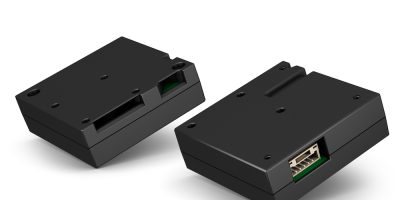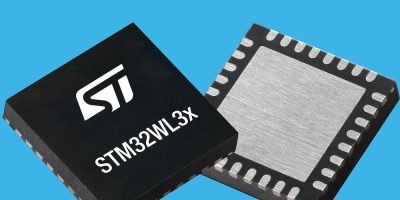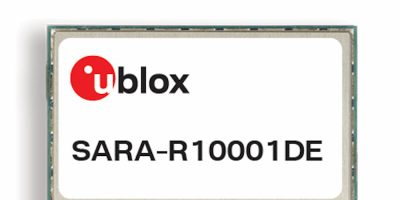ST has announced general availability of STM32WL33 wireless microcontrollers (MCUs), integrating its latest-generation sub-GHz long-range radio, Arm Cortex-M0+ core, tailored peripherals for smart-metering applications, and power-saving enhancements. The new MCUs greatly simplify the design of wireless solutions, reduce time-to-market, and prolong battery life.
These new IoT-focused devices are used in smart utility meters, alarm systems, smart-building equipment, asset-tracking, and proximity detection. Among many other applications in cutting-edge, smart use cases, they are ideal for monitoring and control in smart cities, smart agriculture including reporting soil condition and animal welfare, forest-fire detection, water metering, and leakage detection.
Designers creating new products can take advantage of flexible options, ultra-low-power architecture, best-in-class radio efficiency, and innovative features to optimise the wireless range, simplify the design and extend battery lifetime.
A unique analog flow-sensor controller, LCSC, is integrated to streamline and optimise the design of water metering devices. The LCSC integrated circuitry can operate in conjunction with traditional coil-based mechanical meters, measuring fluid flow without any MCU intervention and providing a suitable anti-tampering feature. With these properties, the LCSC provides safety-proofing and can further enhance battery lifetime to more than 15 years while optimising the integration and cost structure of water metering devices.
In addition, there is an ultra-low-power (4.2µA) receive-only wideband radio that listens for a wake-up signal while the main communication radio is turned off to save power. This always-on radio has negligible impact on battery consumption and provides a standby mode that can quickly react upon receiving a suitable RF wake-up signal. Application use cases include drive-by reading in metering devices or wake-on-service capability in battery-operated monitoring solutions to permit applying firmware upgrades. Moreover, the wake-up signal generated, for instance, by a fixed-position beaconing tag, can transport OOK-modulated information, providing a convenient solution for asset-tracking or location-tags in logistics and warehouse applications.
A comprehensive set of integrated programmable memories, peripherals and security options let developers build richly featured applications with minimal external circuitry. These include 256Kbyte Flash, 32Kbyte SRAM and flexible peripherals including a 16-segment LCD driver, 12-bit 1Msample/s analog-to-digital converter (ADC), analog comparator, digital-to-analog converter (DAC), multiple timers, and a real-time clock (RTC). Security services include secure-boot, secure firmware updates, 128-bit AES, and a random-number generator (RNG).
All the MCUs can operate in either of the 413-479 MHz or 826-958 MHz license-free bands. A special variant, the STM32WL33CCV6A, operates in the 169MHz band.
The device embeds two programmable power amplifiers allowing a selectable RF output power of either +14dBm or +20dBm, further optimising power efficiency during active transmission time. In EU, Korea and Japan, legislation restricts the maximum to +14dBm for energy saving, while North America and Asia-Pacific allow +14dBm or +20dBm for longer range. With their dual power output, STM32WL33 wireless MCUs can be deployed worldwide and provide roaming capability for global tracking applications.
The widely configurable radio allows multi-protocol support and multi-modulation flexibility including 4-(G)FSK up to 600kbit/s, 2-(G)FSK, (G)MSK, DBPSK, DSSS, and ASK. A programmable and autonomous state-machine, the Radio Sequencer, automates common radio operations such as frequency-hopping low-duty-cycle operations, LBT, RX Sniff, auto-ack and many more saving MCU intervention and boosting radio efficiency.
With receive sensitivity of -132 dBm @300 bit/s 433 MHz OOK and -128 Bm @300 bit/s 868 MHz 2(G)FSK, the radio ensures robust communication over long distances. At +20 dBm output power and -128 dBm of sensitivity at 868 MHz, 300 bps GFSK makes it possible to achieve a link budget that supports a wireless communication range of over 1 Km.
There is also an IQ interface for custom modulation schemes and to further enhance reception sensitivity, enabling post-processing exploration with GNURadio or similar tools prior to embedding optimised protocol libraries. Supported standard protocols, besides the fully customisable proprietary options, includes wM-Bus, Mioty, Wize, Sigfox, 6LowPAN as well as Wi-SUN Home-Area-Networking (HAN).
This wireless SoC can combine seamlessly with ST’s MEMS inertial and environmental sensors, leveraging ML/AI algorithms and toolsets provided by ST. This facilitates development of applications that require positional and contextual awareness, as well as battery-operated remote monitoring and wireless sensors in industrial, smart-city or agricultural applications.
As an all-in-one system-on-chip (SoC), the STM32WL33 series connects developers with the extensive STM32 ecosystem. This now includes device-specific STM32CubeWL3 software and middleware, the NUCLEO-WL33CC1 board for 868/915MHz development, and NUCLEO-WL33CC2 for 433MHz. Also, dedicated matched filters (MLPF-WL-01D3/02D3/04D3) are now available for these MCUs, built with ST’s integrated passive device (IPD) technology, that deliver a simple and space-saving solution to optimise RF performance. In addition, a set of reference designs (STDES-WL3xxxx) saves R&D and simplifies RF design, further easing the path to market for new products. Pre-certified and fine-tuned for the STM32WL3 series, these reference designs cover several options including frequency band, RF power, MCU package, and two-layer or four-layer PCB.
The Wireless Studio Environment (STM32CubeWiSE), a graphical-UI based toolset, greatly boosts the learning curve and out-of-the-box experience. This includes the WiSE-RadioCodeGen, a code generator for RF-protocol automation that comes with the dedicated WL33 Radio Sequencer, and the WiSE-RadioExplorer. The explorer helps users make the most of the cutting-edge radio features and navigate the RF testing and certification process.
https://www.st.com







